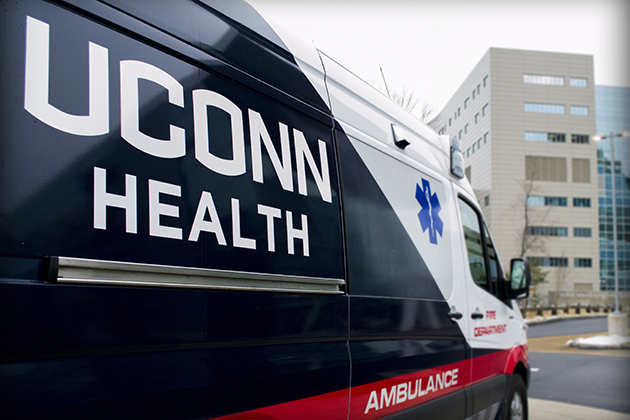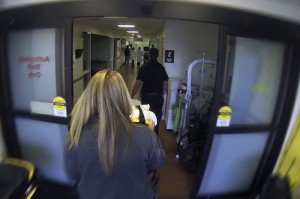
The following was written by Veronica Tucker about an experience she had as a resident physician in the emergency room at UConn Health. The piece was originally published in the November issue of The Journal of Emergency Medicine. Tucker is now an emergency room doctor at Lakes Region General Hospital in Laconia, N.H.
On a beautiful Saturday afternoon, our pagers began going off together—another trauma on its way to the trauma bay. As soon as I looked at the screen, my heart seemed to pause. “Four-year-old girl status post fall from fourth story onto concrete, GCS 11.” As an emergency medicine intern rotating on the trauma service, this was going to be my first pediatric trauma—I was apprehensive, to say the least.
Emergency Medical Services (EMS) rolled in and transferred her to our stretcher, all the while giving their report. “Two-year-old female status post fall from fourth story to concrete, positive loss of consciousness, GCS deteriorated en route, unable to establish airway, IO placed…”
My first thought was, What happened to her being 4 years old? I can’t handle a 2-year-old…I have a 2-year-old at home!
My next thought was how much in awe I was of the multitude of people who were able to fit into that relatively small trauma bay: the adult trauma surgeon, my senior surgery resident, the pediatric surgery attending and his resident; the Emergency Department attending and his senior resident, who was managing the difficult airway; social workers; chaplains; and what seemed like 25 nurses and techs.
My initial role became passing things from the pediatric carts as various attendings and senior residents called out for them: cervical collars, IV equipment, shears, towels, blankets, etc. Even my adult trauma attending was having a hard time getting to the patient, and I remember watching her shove her arm between the people (who seemed to be gathered two or three deep around the bed) just to palpate a pulse.

As the resuscitation proceeded, I noticed that the door was stuck open, mostly because of the high traffic in and out of that room. The patient’s mother was just outside that door, sitting with a social worker and chaplain and trying hard not to fall apart. I realized that if I could see and hear her, she could most certainly see and hear what was transpiring in that trauma bay. At this point, they were attempting to establish an airway, but it was extremely difficult and they ended up needing the pediatric anesthesia attending present. The conversation was audible in snippets, “hypoxic…I need suction…too much vomit and blood.”
I forcibly closed the door and tried to make sure that it stayed closed. I couldn’t bear to imagine what that poor mother was going through and I didn’t want to make her pain worse by having her witness the resuscitation efforts and the conversations taking place.
It felt as though we were in the trauma bay forever before rolling to the CT scanner. Most of that time was taken up in establishing an airway because EMS was unable to do that in the field. Because we are trained to evaluate the airway first, a difficult airway has the capability of delaying the entire resuscitation—something that I witnessed first-hand. As I watched the Emergency Department resident, attending, and pediatric anesthesiologist struggle, I could feel the room’s anxiety level growing. Finally, the airway was established! Everyone in the room let out a collective sigh of relief.
Amazingly, the child did not have any injuries apparent other than head trauma. As she was rolled out through the doors, I remember thinking that she looked so perfect. Her little blond braids were still immaculately in place. Once in the CT scanner, the situation quickly got worse. We had a few images of her brain and could see that she had suffered tremendous closed head trauma and had virtually no gray-white differentiation.
The patient became bradycardic and arrested in the scanner. She was resuscitated and the same thing happened again.
At this point, it was apparent that she would not survive her injuries. The trauma team had a discussion with the patient’s mother, with the social worker and chaplain present. The mother made the final decision to stop the resuscitation and was then brought into the CT scanner to say goodbye to her daughter.
I couldn’t watch as the mother, while sobbing, bent down to kiss her daughter’s perfect forehead. Shortly after, the patient was pronounced dead. The chaplain and social worker led the mother, who was shaking uncontrollably and barely able to walk, to the family waiting room where she would wait to view her daughter’s body.
The patient was cleaned up and wrapped in blankets. The mother sat with her child for hours in an empty room, with nursing supervisors and social workers guarding the doors. Only the local police were let in and out.
I caught a glimpse of the mom while walking by, sitting alone, crying softly while rocking her daughter wrapped in a cocoon of blankets. This broke me and I felt a wave of nausea wash over me. I had to leave the department because I knew that I was on the verge of losing my composure. I went to our residents’ lounge and cried my eyes out. I called home to check on my own daughter who was almost the same age and begged my husband to close all of the windows.
It took me the better part of an hour to regain my composure. I was encouraged to take as much time as I needed by my trauma resident and I could see that she had been crying as well. No one criticized me for reacting the way that I did, and luckily the trauma pager was silent for the rest of the afternoon. I then had a long talk with my trauma attending and she told me that pediatric traumas may get slightly easier to deal with over the years, but that if we ever stop feeling for our patients like this, we need to find a new line of work.
I attended a debriefing a few days later and that also helped me a great deal. I was not an active participant; however, listening to others made me realize that I was not alone in my feelings and helped me process the events of the trauma. I was better equipped to cope with what I, and everyone, had just gone through together. I would encourage anyone in a similar situation to do the same.
I chose a career in Emergency Medicine, so I know that it is inevitable that I will be involved with patients like this from time to time, but that doesn’t make it any easier on a basic, human being, emotional level. Am I too sensitive? Quite possibly, but that’s not something I’m willing to give up.



